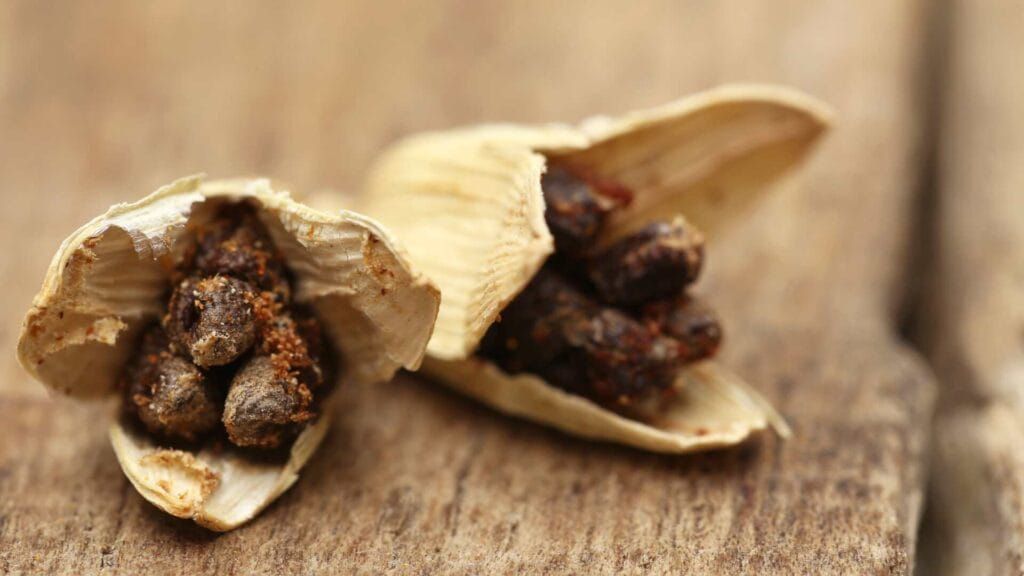When you enter your kitchen, you will feel greeted with the aroma of warm, citrusy, and slightly floral cardamom. Have you ever thought about how this good aroma comes from cardamom? When you infuse it in chai or the flavour of rich biriyanis or use it to intensify traditional sweets like kheer and Gulab Jamun, it gives a luxurious feel to every dish.
But beyond having a speciality in culinary, these tiny cardamom pods hold a world of science within them.
What is the exact thing that makes cardamom so unique? It contains those sets of complex chemical compounds that also help in human health more than just a spice.
In this blog, let’s go deep into the science behind this fascinating ingredient.

Varieties & Origins of Cardamom
Cardamom has been cultivated in dense forests of western ghats in India for thousands of years. The perfect combo suitable for cardamom’s growth is having a tropical climate, high altitude and rich soil makes the spice thrive.
- Spice Originated in Rainforests: Cardamoms have been cultivated for several decades in dense forests of the Western Ghats of India. The Perfect conditions like Tropical climate, high altitude and rich soil density for this spice to thrive.
- Types of Cardamom
We have heard about only cardamom but are not aware of its multiple forms with unique characteristics,
- Green Cardamom (Elettaria Carrdamomum)
The most common and known type is used widely in India for various purposes. It tastes sweet, floral and slightly minty which is preferred to use in desserts, teas, and spice blends of garam masala.
- Black Cardamom(Amomum subulatum)
This type is large with a smoky and earthy flavour and commonly preferred to use in savoury dishes, particularly in North Indian and Tibetan cruises. It contains the qualities to add depth to curries broths and slow-cooked meals.
- White Cardamom
This type of cardamom has a milder flavour than the normal cardamom. It is a bleached version of green cardamom. These cardamom are common in baking and sweets.
Each variety has its unique flavour which is used in different types of dishes to enhance its taste.
The Science Behind the Cardamom‘s Aroma
Have you ever wondered why cardamom’s aroma is that strong? The answer to all your questions lies in its volatile essential oils. Which creates about 2 to 8% of the spice’s dry weight. Some of the major components liable for the aroma are:
1. Eucalyptol (1,8-cineole)
- 1,8-cineole commonly called Eucalyptol gives a cooling and slightly minty scent
- This gives a cooling sensation same as menthol in peppermint. This enables a receptor called TRPM8, which gives you a cooling sensation in the mouth and the nose, and gives a refreshing feel.
2. Terpinyl Acetate
- This gives the cardamom, its flavour of sweet, fruity and slightly floral.
- This base is the major component in green cardamom which is responsible for the sweetness in it.
- This adds to the luxurious aroma of the spice which makes both food and aroma tempting.
3. Limonene
- As we can see, the name by itself reflects lemon that is, it contains a citrusy or lemon-like flavour.
- This compound is already found in peels of citrus fruits, which adds an uplifting and fresh base to the overall cardamom’s fragrance.
4. Myrcene
- This adds a woody, earthy flavour to cardamom
- This enhances the depth of scent in cardamom which balances the sweetness and spiciness in it. This contributes to the aroma on the whole, making it more gathered.
5. Sabinene
- This gives a slight peppery note, a pine-like flavour.
- This gives a mild spiciness like black pepper in cardamom.
6. Linalool
- The final element slightly adds a lavender-like herbal flavour to cardamom, which balances the aroma by giving a soft and floral touch to it.
Each element in cardamom contributes to the multi-dimensional aroma making it a more complex and intriguing spice.

How do these compounds work?
- When the cardamom is crushed these pods release volatile oils into the air stimulating the receptors of our nose.
- That is the reason why freshly ground cardamom smells so good with an intense aroma.
- These compounds also have antimicrobial and antioxidant properties making them natural preservatives.
Chemistry of Flavours
Other spices focus on a single flavour but cardamom is unique with various spices such as sweetness, Bitterness and freshness all at once.
- The science behind its Taste
- The sweetness of the cardamom has originated from terpenes like terpinyl acetate.
- The spiciness comes from cineole which also contributes to its medicinal properties.
- Bitterness comes from flavonoids that give it a slightly sharp edge.
- Cooling effect is similar to menthol which has high cineole content.
Chemical Comparison of Cardamom’s Aroma Based on Variety & Process
Both types of cardamom come from the same botanical family but they differ in their chemical properties:
| Compound | Green Cardamom | Black Cardamom |
| 1,8-Cineole | High | High |
| Terpinyl Acetate | High | Low |
| Limonene | Medium | Low |
| Myrcene | Low | High |
| Sabinene | Medium | High |
| Linalool | High | Low |
- Green Cardamom contains high terpinyl acetate, which makes it taste more sweeter and floral.
- Black Cardamom has a great earthy flavour as it contains a higher level of myrcene and sabinene, which is developed during the drying process in open flames.

The Effects of Roasting and Drying
- The one process in which cardamom retains more of its freshness and floral notes is sun drying. This method more time to dry.
- The next is what happens when you roast your cardamom. Doing this will develop a deep and toasted aroma as the myrcene element debases itself into multiplex molecules.
- Then, black cardamom gives a smoky scent that comes from the reaction of oils and the smoke that comes from wood.
Final Thoughts
Cardamom’s aroma is a perfect combo of chemistry, volatility, and perception of humans. The essential oil in it contains a mix of citrusy, floral, a little bit spicy and cooling elements that make this spice an all-in-one spot of multiple scents in nature. This is used in multiple things like food, medicine, perfumes and everything explaining the science behind its aroma and why cardamom remains so captivating. Take a deep breath to smell this molecular magic in a single moment.
Related Articles:





0 Comments